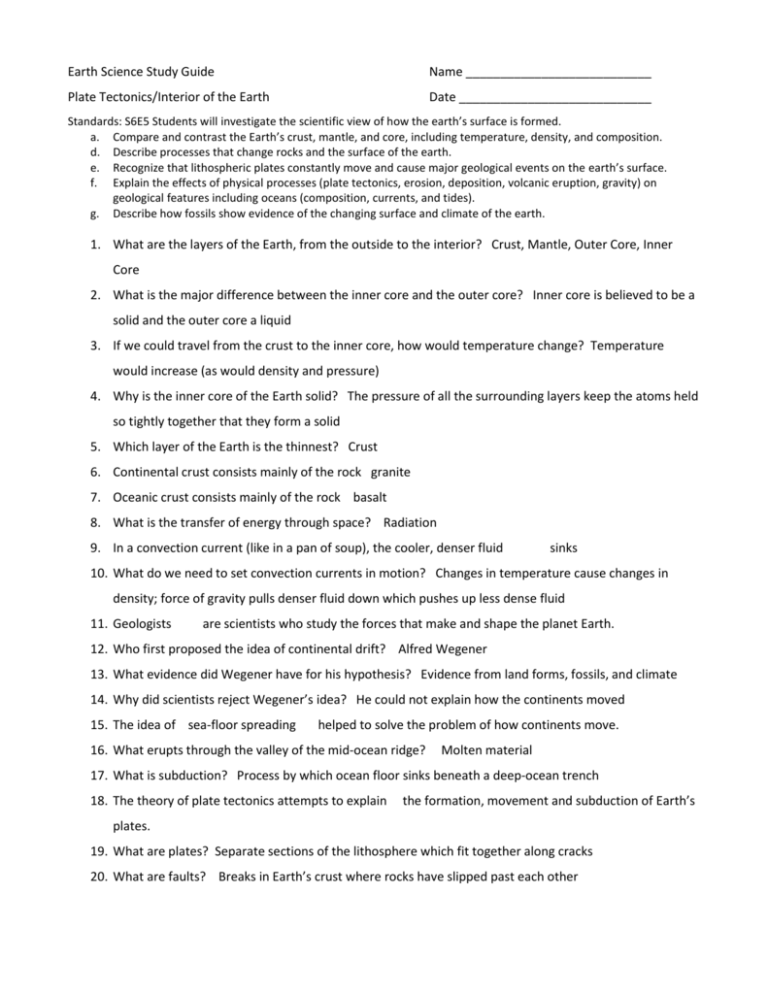Study Guide Answer Key for Plate Tectonics
advertisement

Earth Science Study Guide Name ___________________________ Plate Tectonics/Interior of the Earth Date ____________________________ Standards: S6E5 Students will investigate the scientific view of how the earth’s surface is formed. a. Compare and contrast the Earth’s crust, mantle, and core, including temperature, density, and composition. d. Describe processes that change rocks and the surface of the earth. e. Recognize that lithospheric plates constantly move and cause major geological events on the earth’s surface. f. Explain the effects of physical processes (plate tectonics, erosion, deposition, volcanic eruption, gravity) on geological features including oceans (composition, currents, and tides). g. Describe how fossils show evidence of the changing surface and climate of the earth. 1. What are the layers of the Earth, from the outside to the interior? Crust, Mantle, Outer Core, Inner Core 2. What is the major difference between the inner core and the outer core? Inner core is believed to be a solid and the outer core a liquid 3. If we could travel from the crust to the inner core, how would temperature change? Temperature would increase (as would density and pressure) 4. Why is the inner core of the Earth solid? The pressure of all the surrounding layers keep the atoms held so tightly together that they form a solid 5. Which layer of the Earth is the thinnest? Crust 6. Continental crust consists mainly of the rock granite 7. Oceanic crust consists mainly of the rock basalt 8. What is the transfer of energy through space? Radiation 9. In a convection current (like in a pan of soup), the cooler, denser fluid sinks 10. What do we need to set convection currents in motion? Changes in temperature cause changes in density; force of gravity pulls denser fluid down which pushes up less dense fluid 11. Geologists are scientists who study the forces that make and shape the planet Earth. 12. Who first proposed the idea of continental drift? Alfred Wegener 13. What evidence did Wegener have for his hypothesis? Evidence from land forms, fossils, and climate 14. Why did scientists reject Wegener’s idea? He could not explain how the continents moved 15. The idea of sea-floor spreading helped to solve the problem of how continents move. 16. What erupts through the valley of the mid-ocean ridge? Molten material 17. What is subduction? Process by which ocean floor sinks beneath a deep-ocean trench 18. The theory of plate tectonics attempts to explain the formation, movement and subduction of Earth’s plates. 19. What are plates? Separate sections of the lithosphere which fit together along cracks 20. What are faults? Breaks in Earth’s crust where rocks have slipped past each other 21. What happens when two plates carrying continental crust collide? Mountain ranges are formed because neither crust is dense enough to subduct under the other 22. What happens when a plate carrying continental crust and a plate carrying oceanic crust collide? The denser oceanic crust subducts under the less dense continental crust—volcanoes often form along the continent’s border 23. How were the Himalayas created? When the subcontinent of India collided, or converged, with the continent of Asia (two convergent continental plates) 24. Which ocean is shrinking? How is this possible? The Pacific—its many trenches are subducting crust faster than new crust is being created at the mid-ocean ridges 25. Which ocean is expanding? How is this possible? The Atlantic—the mid-ocean ridge is adding more crust faster than the trenches are subducting crust 26. What are the three types of plate boundaries and the movement with each convergent—two plates colliding, or coming together; divergent—two plates moving away from each other; transform—two plates slipping past each other, side-to-side motion 27. What features are associated with each plate boundary convergent—continent-continent—mountains, ocean-ocean—deep-ocean trench, continent-ocean—deep-ocean trench, volcanoes; divergent— continent-continent—rift valley, ocean-ocean—mid-ocean ridge; transform—no specific feature, just earthquakes 28. At which type of plate boundary is crust added? Divergent At which boundary is it lost? convergent True or False—Circle true if the statement is true and false if the statement is false. If the statement is false, change the underlined word or words to make the statement true. 29. True False Heat transfer by the movement of a heated fluid is called convection. _________________________ 30. True False The lithosphere includes all of the core and part of the mantle. _________Crust________________ 31. True False The process that continually adds new material to the ocean floor is continental drift. ________sea-floor spreading_________________ 32. True False As oceanic crust moves away from the mid-ocean trench, it cools and becomes denser. ________mid-ocean ridge_________________ 33. True False The asthenosphere is the part of the mantle that can bend like plastic. _________________________ 34. True False Wegener called the supercontinent that he believed once existed Pangaea. _________________________









